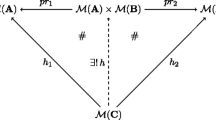Abstract
We share with Foulis and Randall the evangel that it is not orthomodular posets or the like, but manuals of operations that are of primary importance in the foundations of the empirical sciences. In sharp contrast to them, we regard an operation not as a set of possible outcomes, but as a complete Boolean algebra of observable events, which we adopt, following the lines of Davis and of Takeuti, as a building block of our empirical set theory. Just as a smooth manifold is covered by open subsets of a Euclidean space interconnected by smooth mappings, our empirical set theory is covered by the Scott-Solovay universesV (B) over complete Boolean algebrasB interconnected by geometric morphisms. Using the nomenclature of topos theory, our empirical set theory is a subcategory of the categoryBIop of Boolean localic toposes and geometric morphisms. It is shown that in this set theory observables can be identified with real numbers. This is the first step of formal development of Davis' ambitious program.
Similar content being viewed by others
References
Bell, J. L. (1988).Toposes and Local Set Theories, Oxford University Press, Oxford.
Davis, M. (1977).International Journal of Theoretical Physics,16, 867–874.
Dixmier, J. (1981).Von Neumann Algebras, North-Holland, Amsterdam.
Foulis, D. J., and Randall, C. H. (1972).Journal of Mathematical Physics,13, 1667–1675.
Foulis, D. J., and Randall, C. H. (1974a). The empirical logic approach to the physical sciences, inLecture Notes in Physics, Vol. 29, Springer-Verlag, Berlin, pp. 230–249.
Foulis, D. J., and Randall, C. H. (1974b).Synthese,29, 81–111.
Foulis, D. J., and Randall, C. H. (1978). Manuals, morphisms, and quantum mechanics, inMathematical Foundations of Quantum Theory, A. R. Marlow, ed., Academic Press, New York, pp. 105–126.
Goldblatt, R. (1979).Topoi, North-Holland, Amsterdam.
Gudder, S. P. (1988).Quantum Probability, Academic Press, San Diego, California.
Jech, T. (1978).Set Theory, Academic Press, New York.
Kolmogorov, A. N. (1956).Foundations of the Theory of Probability, 2nd ed., Chelsea, New York.
Koppelberg, S. (1989).Handbook of Boolean Algebras, Vol. 1, North-Holland, Amsterdam.
MacLane, S. (1971).Categories for the Working Mathematician, Springer-Verlag, New York.
MacLane, S., and Moerdijk, I. (1992).Sheaves in Geometry and Logic, Springer-Verlag, New York.
Manes, E. G. (1976).Algebraic Theories, Springer-Verlag, New York.
Nishimura, H. (1992).International Journal of Theoretical Physics,31, 855–869.
Nishimura, H. (1993).International Journal of Theoretical Physics,32, 443–488.
Pták, P., and Pulmannová, S. (1991).Orthomodular Structures as Quantum Logics, Kluwer, Dordrecht.
Randall, C. H. (1966). A mathematical foundation for empirical science, Ph.D. Thesis, Rensselaer Polytechnic Institute, Troy, New York.
Randall, C. H., and Foulis, D. J. (1973).Journal of Mathematical Physics,14, 1472–1480.
Randall, C. H., and Foulis, D. J. (1976). A mathematical setting for inductive reasoning, inFoundations of Probability Theory, Statistical Inference, and Statistical Theories of Science, Vol. III, W. L. Harper and C. A. Hooker, eds., Reidel, Dordrecht, pp. 169–205.
Randall, C. H., and Foulis, D. J. (1979). The operational approach to quantum mechanics, inPhysical Theories as Logico-Operational Structure, C. A. Hooker, ed., Reidel, Dordrecht, pp. 167–201.
Segal, I. E. (1951).American Journal of Mathematics,73, 275–313.
Sikorski, R. (1969).Boolean Algebras, 3rd ed., Springer-Verlag, Berlin.
Stout, L. N. (1979).Manuscripta Mathematica,28, 379–403.
Takeuti, G. (1978).Two Applications of Logic to Mathematics, Iwanami, Tokyo, and Princeton University Press, Princeton, New Jersey.
Takeuti, G. (1980).Intuitionistic Set Theory, Kinokuniya, Tokyo [in Japanese].
Takeuti, G. (1981a). Logic and set theory, inModern Logic—A Survey, E. Agazzi, ed., Reidel, Dordrecht, pp. 169–171.
Takeuti, G. (1981b). Quantum set theory, inCurrent Issues in Quantum Logic, E. G. Beltrametti and B. C. van Fraassen, eds., Plenum Press, New York, pp. 303–322.
Takeuti, G. (1983). Quantum logic and quantization, inProceedings International Symposium on the Foundations of Quantum Mechanics, S. Kamefuchiet al., eds., Tokyo, pp. 256–260.
Takeuti, G., and Zaring, W. M. (1973).Axiomatic Set Theory, Springer-Verlag, New York.
Tomita, M. (1952).Memoirs of the Faculty of Science, Kyūsyū University, Series A,7, 51–60.
Varadarajan, V. S. (1962).Communications in Pure and Applied Mathematics,15, 189–217.
Varadarajan, V. S. (1968).Geometry of Quantum Theory, Vol. I, Van Nostrand, Princeton, New Jersey.
Author information
Authors and Affiliations
Rights and permissions
About this article
Cite this article
Nishimura, H. Empirical set theory. Int J Theor Phys 32, 1293–1321 (1993). https://doi.org/10.1007/BF00675196
Received:
Issue Date:
DOI: https://doi.org/10.1007/BF00675196



